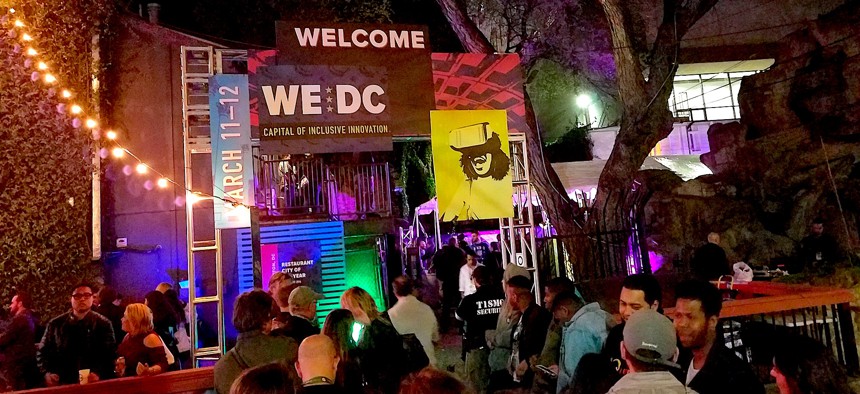Cities Join the Branding Bonanza

The WeDC House in Austin, Texas Mitch Herckis / Route Fifty
The nation’s cities are among the many brands trying to promote themselves to innovators at SXSW.
AUSTIN, Texas — Cities from across the nation are promoting themselves as hubs for the creative and savvy. Whether it’s New York City, Philadelphia, Fort Worth, or Atlanta, cities are choosing to set up destinations during the annual SXSW festival that give the city a brand, and innovators and startups a destination to learn more about the community.
The ultimate goal? To build local economic development by putting the city front and center to the hundreds of thousands of innovators and entrepreneurs who descend on Austin for the week.
One of the staples over the past few years is the WeDC House, where the nation’s capital shows off its non-federal side to the technology, venture capital, music and film industries that swarm SXSW.
“Last year we broke all sorts of records as far as our own personal activation numbers, having over 9,000 people come through the WeDC house in two and a half days, and having social media hits north of 483 million impressions,” Keith Sellars, president of the Washington, D.C. Economic Partnership told Route Fifty. According to Sellars, whose organization partners with the city every year on the project, the WeDC house was “trending with some of the top brands” during SXSW 2017.
Like Dell and hundreds of other corporate brands that also build out spaces in Austin for SXSW, the branding allows them to build awareness and market to those who are looking to invest or even settle in new areas.
For Washington, D.C., the message to the 400,000-plus people who attend SXSW is that the city is the “capital of inclusive innovation,” according to D.C. Deputy Mayor Brian Kenner.
“We feel like we have got a few competitive advantages,” Kenner explained to Route Fifty. “We know that we are not going to be Silicon Valley; we are not trying to be Silicon Valley, but we do know … we have the highest percentage of female entrepreneurs in technology and innovation; we know we have one of the country’s highest concentration of people of color entrepreneurs.”
The message and the strengths of the city are on full display this year, as the WeDC House hosts conversations like “Demystifying the Female Founder,” as well as a technology pitch competition hosted by Black Girl Ventures.
It’s not the traditional transactional economic development work that most think of cities doing at most trade shows—but it isn’t supposed to be.
Sellars points out there’s efficiency at the festival, explaining that “you can hit it on multiple platforms versus doing a one-off in various cities, you can reach these people by telling your story in one place to various audiences.”
“The younger generation, they’re receiving information minute-by-minute, hourly, so branding your city, getting those positive messages about your city, is very efficient, and very effective,” Sellars said.
Kenner keeps track of opportunities created through the “activation” at SXSW, and says it is not only just getting companies and startups interested in locating themselves in the district, but also creating opportunities for those startups from the city to have a central place to promote their brand and create that special SXSW collaborative convergence.
“When we are able to create those positive reverberations it does nothing but really help,” said Kenner.
Building a Brand
Washington, D.C.’s branding success at SXSW wasn’t built overnight. Rather, it was slow and intentional work aimed at large economic concerns that were on the horizon.
In 2013, agreements in Congress over “sequestration” signaled the potential for long-term contraction of the District of Columbia’s largest employer, Uncle Sam.
“We started thinking about, being the innovative government we are, how can we diversify our economy, and we saw the tech sector as an awesome opportunity to do so,” Chanda Washington, Kenner’s communications director, told Route Fifty.
Kenner, Sellars and leaders from the local public and private sector have been growing D.C.’s SXSW presence slowly and deliberately ever since. That meant talking with cities who had built presences at the conference in multiple different ways before taking their first dip in the water with a small space and then ultimately a large house.
Early on, the District’s presence was more “scattershot,” according to Kenner. “We were trying to focus a little bit in film, a little bit in tech, a little bit in music, a little bit in lots of different things.”
Kenner says D.C. ultimately identified more success by focusing on its core “pillars.” He and Sellars would suggest other cities looking to build a brand at SXSW do the same.
“My biggest takeaway is just go for what you’re good at—find your strengths and then focus on that because that’s where you’re going to get your impact from,” Kenner said.
ALSO from Route Fifty’s coverage from SXSW 2018:
Mitch Herckis is Senior Director of Programs for Government Executive’s Route Fifty and is based in Washington, D.C.
NEXT STORY: 4 reasons enterprise open source works best






